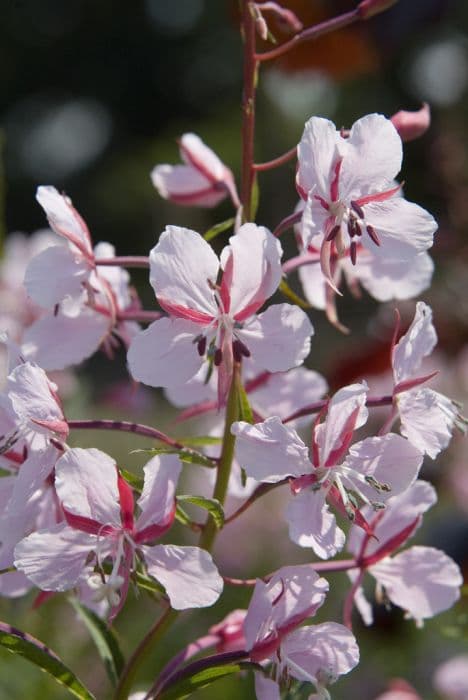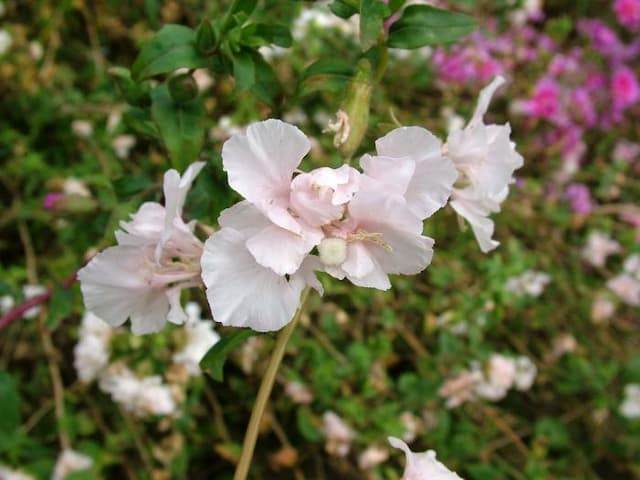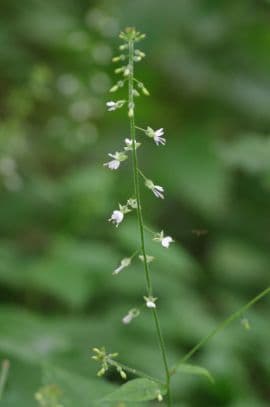Fuchsia Fuchsia 'Checkerboard'

ABOUT
Fuchsia 'Checkerboard' is an ornamental plant known for its striking and unusual flowers. These blossoms are characterized by their vibrant colors and distinctive form. The flowers dangle like delicate pendants from the branches, each one showcasing a graceful bell-like structure. The petals are typically bicolored, with the outer segments exhibiting a deep purple or red hue, which beautifully contrasts with the inner parts, often a pure white or pale pink. These inner petals are shorter and flare out like the skirt of a tutu, giving an intricate checkerboard pattern for which the plant is named. The foliage of Fuchsia 'Checkerboard' adds to its attractiveness with leaves that are typically dark green, though they can have a slight purplish tint depending on environmental conditions. These leaves are oval-shaped with softly serrated edges, and they provide a lush backdrop to the vivid blossoms. The stems of the plant are slender and may have a trailing or upright growth habit, often depending on how the plant is maintained. Fuchsia 'Checkerboard' is popular among gardeners and plant enthusiasts for its decorative flowers and has an elegant appearance that makes it a favorite for hanging baskets, patio containers, and garden beds where its cascading blooms can be displayed to full advantage.
About this plant
 Names
NamesFamily
Onagraceae
Synonyms
Ladies' Eardrops, Fairy Fuchsia
Common names
Fuchsia 'Checkerboard'
 Toxicity
ToxicityTo humans
Fuchsia, including the 'Checkerboard' variety, is generally regarded as non-toxic to humans. If ingested in large quantities, it may cause mild gastrointestinal discomfort, but it does not typically cause poisoning or serious symptoms in people.
To pets
Fuchsia plants are also considered non-toxic to pets. They are not known to cause serious harm if pets nibble on them. However, as with any non-food plant material, ingestion of large amounts may potentially cause mild gastrointestinal upset in sensitive individuals.
 Characteristics
CharacteristicsLife cycle
Perennials
Foliage type
Deciduous
Color of leaves
Green
Flower color
Mixed
Height
2 feet (60 cm)
Spread
2 feet (60 cm)
Plant type
Shrub
Hardiness zones
9
Native area
Central America
Benefits
 General Benefits
General Benefits- Ornamental Appeal: Adds vibrant color and visual interest with its striking bicolor blooms.
- Attracts Pollinators: Flowers provide nectar for bees, hummingbirds, and other pollinators.
- Versatile Use: Suitable for outdoor gardens, hanging baskets, and indoor containers.
- Shade Tolerance: Performs well in partial shade, offering gardening options in less sunny spots.
- Long Blooming Period: Flowers prolifically from spring to fall, providing extended beauty.
- Easy Propagation: Can be easily propagated from cuttings, allowing for garden expansion or sharing with others.
- Garden Filler: Helps fill in garden gaps with its bushy growth habit and abundant foliage.
 Medical Properties
Medical PropertiesThis plant is not used for medical purposes.
 Air-purifying Qualities
Air-purifying QualitiesThis plant is not specifically known for air purifying qualities.
 Other Uses
Other Uses- Fuchsia 'Checkerboard' can be used for creating colorful jellies and jams, as some fuchsia fruits are edible and give a unique tart flavor.
- The flowers of Fuchsia 'Checkerboard' can be candied and used as decorative and edible additions to desserts and cakes.
- These plants can be utilized in educational programs for gardeners on how to maintain and propagate hanging basket plants.
- Fuchsia 'Checkerboard' can serve as a natural dye source for fabrics, providing beautiful pink and purple hues.
- This plant is often used in art and photography projects due to its striking and vivid flowers providing an excellent subject matter.
- Their blossoms can decorate mocktails and cocktails; the vibrant colors add an unexpected twist to beverages.
- Fuchsia 'Checkerboard' can be incorporated into wedding bouquets and arrangements for a pop of color and uniqueness.
- The plant can be used as part of pet-safe garden areas, as Fuchsia 'Checkerboard' is nontoxic to animals.
- Insect enthusiasts can use fuchsias to attract and study various pollinators like bees and hummingbirds that are drawn to the flowers.
- They can be included in living walls or vertical gardens, contributing to urban greening with their cascading growth habit.
Interesting Facts
 Feng Shui
Feng ShuiThe Fuchsia is not used in Feng Shui practice.
 Zodiac Sign Compitability
Zodiac Sign CompitabilityThe Fuchsia is not used in astrology practice.
 Plant Symbolism
Plant Symbolism- Grace: The fuchsia plant, with its delicate, teardrop-shaped flowers, often symbolizes grace and elegance due to its sophisticated shape and mesmerizing movement in the breeze.
- Good Taste: Fuchsia flowers are sometimes associated with good taste and refinement, possibly reflecting the plant's vivid yet harmonious color combinations and its popularity among horticultural enthusiasts.
- Ardent Love: The rich colors and the long-lasting blooms of the fuchsia plant are commonly linked to deep and passionate love, expressing a heartfelt connection that is both bold and tender.
- Confiding Love: Offering a fuchsia to someone is traditionally understood as a way to confide your love to them, making it a plant used to communicate personal, deep feelings between individuals.
- Overflowing Abundance: With its prolific flowering and tendency to produce a profusion of blossoms, the fuchsia can symbolize abundance, generosity, and a wealth of positive energy.
 Water
WaterFuchsia, commonly known as Lady’s eardrops, requires consistent moisture. Water the plant when the top inch of soil feels dry, usually every few days during the active growing season. It is important not to let the soil dry out completely but equally important to avoid waterlogging. Aim to water with 1 to 2 gallons per week, depending on climate and weather conditions. During hot, dry spells, watering frequency should be increased. In winter, reduce watering but do not allow the plant to dry out completely.
 Light
LightLady’s eardrops thrive in bright, indirect light. They prefer a location that receives morning sunlight and afternoon shade, as too much direct sunlight can scorch the leaves. An eastern-facing window or a spot under a tree that provides dappled sunlight is ideal. These conditions mimic their natural habitat and will help maintain vibrant foliage and flower production.
 Temperature
TemperatureLady’s eardrops flourish in temperatures between 55 to 75 degrees Fahrenheit. They can tolerate minimum temperatures down to about 40 degrees Fahrenheit, but they should be protected from frost. The maximum temperature for these plants should not exceed 80 degrees Fahrenheit, as higher temperatures can cause stress. These temperature ranges promote healthy growth and flowering.
 Pruning
PruningPruning Lady’s eardrops is important to maintain a bushy growth habit and to encourage prolific blooming. Pinch or cut off the tips of the stems during the growing season to promote branching. After flowering, prune back by one-third to help rejuvenate the plant and prepare it for the next growth cycle. Pruning is best done in late winter or early spring before new growth begins.
 Cleaning
CleaningAs needed
 Soil
SoilFuchsia 'Checkerboard' prefers a moist, well-draining soil mix with a pH between 6 and 7. A mixture of peat, loam, and sand in equal parts is ideal to provide the necessary aeration and moisture retention.
 Repotting
RepottingFuchsia 'Checkerboard' should be repotted annually in the spring to refresh the soil and accommodate growth. Larger plants may be repotted every two to three years.
 Humidity & Misting
Humidity & MistingFuchsia 'Checkerboard' thrives in high humidity levels, around 60-70%. Providing a humid environment will help maintain the health and vibrancy of the flowers.
 Suitable locations
Suitable locationsIndoor
Place in bright, indirect light, and keep the soil moist.
Outdoor
Protect from afternoon sun; hang in sheltered locations.
Hardiness zone
6-11 USDA
 Life cycle
Life cycleFuchsia 'Checkerboard', commonly known as Checkerboard Fuchsia, begins its life cycle as a seed, which upon germination gives rise to a small seedling. The seedling then grows into a young plant, developing a root system and foliage. As it matures, the Checkerboard Fuchsia enters a vegetative state where it focuses on leaf and stem growth. Following the vegetative stage, it starts the flowering stage, producing distinctive pendulous flowers with a checkerboard pattern of coloration. After pollination, usually by hummingbirds or insects, the plant sets fruit, which contains seeds for the next generation. Finally, as an annual or short-lived perennial in some climates, it completes its life cycle when it dies back after seed dispersion, although in favorable conditions it can be overwintered and continue growth in the following season.
 Propogation
PropogationPropogation time
Spring-Early Summer
The Fuchsia 'Checkerboard', commonly known as Fuchsia, is best propagated through softwood cuttings and this is often done in late spring or early summer. To propagate using this method, gardeners typically take a cutting about 2 to 4 inches long, with several sets of leaves. They will remove the bottom set of leaves to expose a node, where roots will form. The stem cutting is then dipped into a rooting hormone powder to stimulate root growth and is planted in a moistened mix of peat and perlite. This setup is often covered with a plastic bag or placed in a propagator to maintain high humidity, and kept in indirect light. Roots usually develop within a few weeks, after which the cutting can be potted as a new plant.









